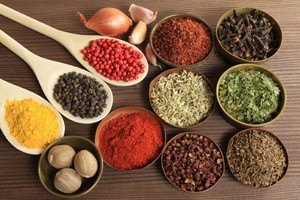Natural painkillers in your kitchen

The ancient Ayurveda texts mention many natural ingredients for pain relief that you will find among the herbs, spices and condiments in your kitchen.
by Joanne Henning Tedesco —
Ayurveda is a 5,000-year-old natural healing system that has its origins in the Vedic culture of India. Although suppressed during the years of foreign occupation, Ayurveda has been enjoying a major resurgence in both its native land and throughout the world.
The ancient Ayurveda texts mention many natural ingredients for pain relief that you will find among the herbs, spices and condiments in your kitchen. Listed below are a few of them.
Ginger (aadrak) — For many digestive maladies, like indigestion, excessive gas, abdominal pain and piles, ginger can provide relief. Ginger can also help many types of respiratory disorders, such as cough, cold, asthma, pneumonia, bronchitis, etc. Joint pains from arthritis, gout, and other forms of joint and muscle pains can also be relieved using ginger. Mix ginger powder into sesame seed oil and massage into the joint, followed by a hot fomentation for pain relief.
Licorice (mulathee or yastimadhu) — The herb licorice can be used both for preventive and curative purposes, including mouth ulcers. A decoction prepared from licorice may be used for both gargling and swallowing. Licorice can give pain relief from mouth ulcers, throat pain and vocal-cord inflammation.
Onion (pyaz) — A storehouse of health care merits, onion can be used for pain and inflammation due to bruise, injury or contusion. For relieving pain, prepare a paste by pounding onions, then heat the paste. Apply on the site for relief from the pain and inflammation.
Aloe vera (ghrit kumari) — The juice of aloe vera is beneficial in healing wounds, edema, pain, inflammation and skin diseases. Both external and internal use is recommended for generalized pain and swelling. Mix aloe vera pulp and turmeric powder. Heat over a low flame and apply to the swollen or painful area.
Black pepper (kali mirch) — Black pepper invigorates the gastric fire, works as a wormicide and acts as a painkiller for toothache and pain in the gums. Crush or pound a few peppercorns into powder form, and massage the gums with the powder to relieve pain and prevent frequent dental problems.
Camphor (mushak kapoor) — Camphor helps relieve inflammation and pain at the site of injury or wound. Sprinkle powder of camphor on the injury to combat inflammation, blood loss and pain. This also helps prevent degeneration of the wound.
Clove (lavang) — Clove not only adds to the taste and flavor of food, but is also known for its health benefits and for relieving pain. To relieve toothache pain, press a clove between the teeth or put cotton dipped in clove oil into the dental crevice. This pain reliever also has a germicidal action.
Coconut (nariyal) — The use of coconut has been emphasized in Ayurveda for relieving ailments that result from increased heat in the body, including hyperacidity, gastritis, heartburn and excessive thirst. Coconut water has the property to subside both heat and pain. To reduce pain and associated symptoms, take some sips of coconut water every two hours.
Source: curejoy.com.
Joanne Henning Tedesco is editor of AzNetNews.
Reprinted from AzNetNews, Volume 34, Number 3, June/July 2015.





July 20, 2015
Featured, June/July 2015 Issue, Pain